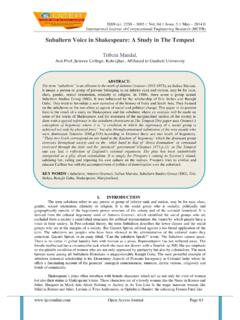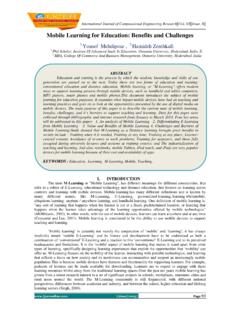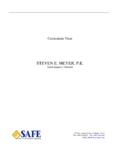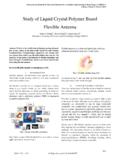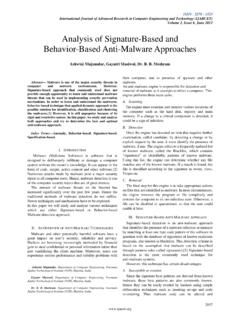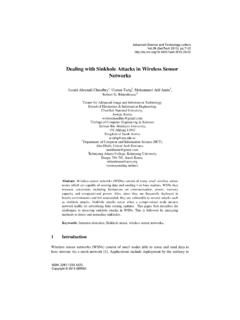Transcription of Performance Comparison of Uncoded & Coded …
1 International Journal of Computational Engineering Research||Vol, 03||Issue, 4|| ||April||2013|| Page 186 Performance Comparison of Uncoded & Coded Adaptive OFDM System over AWGN Channel Swati M. Kshirsagar1 , A. N. Jadhav2 12 Department of E & TC, Patil College of Engg. & Tech., Kolhapur ,Maharashtra, India. I. INTRODUCTION Orthogonal Frequency Division Multiplexing (OFDM) is the most popular modulation technique for wireless communications. OFDM is a digital multicarrier modulation scheme which uses a large number of closely spaced orthogonal subcarriers [2].
2 OFDM signals are generated using the Fast Fourier transform. Each individual carrier, commonly called as subcarrier. Each subcarrier is modulated with a conventional modulation scheme at a low symbol rate, maintaining data rates similar to conventional single carrier modulation schemes in the same bandwidth. OFDM is a logical next step in broadband radio evolution. It is applied in IEEE standards like IEEE (Wi-Fi) and (WiMAX). OFDM is flexible to adapt modulation schemes on subcarriers according to instantaneous SNR. Adaptive OFDM (AOFDM) is the important approach to fourth generation of mobile communication.
3 Adaptive modulation scheme is employed according to channel fading condition to improve OFDM Performance . This improves data rate, spectral efficiency & throughput. In this paper, we analyze Bit Error Rate (BER), Mean Square Error (MSE), Spectral Efficiency, Throughput Performance of Coded adaptive OFDM with BPSK,QPSK & QAM modulation over AWGN channel. II. SYSTEM MODEL : Figure 1. Adaptive OFDM system The system model for Adaptive OFDM system is as shown in .The data is generated with the help of data generator.
4 It is represented by a code word that consists of prescribed number code elements. The transmitter first converts this data from serial stream to parallel sets. Each set of data contains one symbol, Si, for each subcarrier . For example, a set of four data would be [S0 S1 S2 S3]. The flexibility to rigorous channel conditions can be further improved if information about the channel is sent over a return channel. Based on this feedback information adaptive modulation & channel coding may be applied across all subcarriers or individually to each subcarrier.
5 Abstract Adaptive OFDM (AOFDM) is the important approach to fourth generation of mobile communication. Adaptive modulating scheme is employed according to channel fading condition for improving the Performance of OFDM. This gives improved data rate, spectral efficiency & throughput. OFDM is flexible to adapt modulation schemes on subcarriers according instantaneous signal-to-noise ratio (SNR). In this paper, we compare Bit Error Rate (BER),Mean Square Error(MSE), Spectral Efficiency, Throughput Performance of Uncoded & Coded adaptive OFDM with BPSK,QPSK & QAM modulation over AWGN channel.
6 Keywords: AOFDM,BER , FFT,MSE, OFDM,SNR, Spectral Efficiency, Throughput Performance Comparison Of Uncoded & ||April||2013|| Page 187 An inverse Fourier transform (IFFT) converts the frequency domain data set into samples of the corresponding time domain representation. Specifically IFFT is useful for OFDM because it maintains orthogonality between subcarriers. Since the duration of each symbol is long it is feasible to insert a guard interval between the OFDM symbols.
7 Thus eliminating intersymbol interference. Parallel to serial block creates the OFDM signal by sequentially outputting the time domain samples. At receiver guard interval is removed. FFT is applied to have frequency domain signals. Adaptive demodulator does the reverse of modulator. The channel estimator is used to estimate the instantaneous SNR of the received signal. Based on the instantaneous SNR the best mode will be selected for next transmission frame. This task is done by the mode selector block [1].
8 The channel estimation and mode selection are done at the receiver side and the information is sent to the transmitter using a feedback channel [4]. In this model the adaptation is done frame by frame. At the transmitter the adaptive modulator block consists of different modulators which are used to provide different modulation modes. The switching between these modulators will depend on the instantaneous SNR. This system model is used to describe three types of modulation schemes as BPSK, QPSK & QAM. III. SYSTEM PARAMETERS: Table1.
9 System Parameters Parameter Value IFFT size 512 Number of subchannels N 512 Number of subband 32 Number of subcarriers per subband 16 SNR 0-30dB Guard interval N/4 128 Pilot interval 8 Modulation scheme BPSK, QPSK, QAM Channel length L 16 Number of pilots(P= N/8) 64 OFDM system parameters considered here to analyze the Bit Error Rate (BER),Mean Square Error, Spectral Efficiency, Throughput Performance of Uncoded & Coded adaptive OFDM with BPSK,QPSK & QAM modulation over AWGN channel are mentioned in Table1.
10 IV. RESULTS & DISCUSSIONS: Here we analyzed the the Bit Error Rate (BER),Mean Square Error, Spectral Efficiency, Throughput Performance of Uncoded & Coded adaptive OFDM with BPSK,QPSK & QAM modulation over AWGN channel. Here we used Cyclic coding. & shows BER Performance of Uncoded & Coded adaptive OFDM respectively. It is observed from that for SNR is in between 0 dB - 3dB, highest modulation scheme is used. For SNR is between 3dB - 6dB, 32 QAM is used. When SNR is in between 6dB - 9dB modulation scheme 16 QAM is used.


